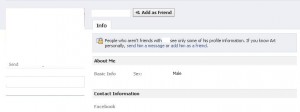How Safe are Those “Off-line” Officers?
I have posted about online officer safety previously. I know many officers, particularly those uncomfortable with the Internet, have taken the approach of avoiding cyberspace like the plague, particularly social networking sites. After all, you can’t be a victim in cyberspace if you don’t venture there right? But I think that might be a variation of the ostrich head in the sand approach…surely the lion will not eat me if he can’t see my head. Some recent events have got me thinking that avoidance might not be the best strategy and here’s why.
Having an online presence is “staking claim” to one’s digital identity. If one doesn’t establish one they run the real risk that someone will go online and do it for them. It really isn’t all that hard for someone to create a fake social networking site. Recently researchers from the University of British Columbia (BC) found that Facebook’s fake account detection mechanisms can be defeated 80 percent of the time with the help of automated tools.
Now the BC researchers were looking at tools that hackers might use to create hundreds of bogus accounts to spam and/or steal information from hundreds or thousands of legitimate users. However, if one is going to create a single false account the detection rate is probably much lower. Individuals have been able to successfully create these individual accounts and basically cyberharrass their victims. That is exactly what one New Jersey women is accused of doing when she alleged created a false Facebook account in her ex-boyfriend’s name and peppered it with “unpleasantries.”
Here is what might happen with an officer who doesn’t have any cyber-presence. An offender or their associate creates one in the officer’s name. They might even obtain a picture from somewhere and post it to the profile. Sprinkle with the name of the officer’s current employer, their interests, (how many officers have pictures of themselves fishing or smoking cigars or with their favorite sports team memorabilia on display) and mix in the college they attended (yep, those college diplomas are proudly displayed in many offices) and you have a profile that might easily pass as legitimate.
Now the offender might have some fun with it and use it to post inappropriate comments or pictures. But lets take it a step further. They might use it to communicate with the officer’s other offenders or even their co-workers. Gee all this might take some explaining to a supervisor. I am sure it would get sorted out but what a hassle in the meantime. But lets say they don’t do that with it. Lets say they just leave it out there, for the officer’s real friends and family to connect with. Sure some officers refuse to venture into cyberspace but what about their families and friends? Are they so unwilling to get online? Social networking sites are designed to search out new connections for their users. How long before the offender with the bogus officer profile gets connected to the officer’s family and friends? Once connected they can collect information about who the officer’s close family and friends are and where they can be located. What would an offender do with that information? We are dealing in a world where identity theft is prolific. There are also cases of cyber-impersonating occurring in the news with some regularity. It is not a matter of if but when an officer gets impersonated in cyberspace.
The point to all this is officers must take control of their Internet presence. They can’t just leave it to chance or ignore it. If an officer creates a profile and connects with their friends/family they have established a barrier of sorts to an offender creating a fake profile to obtain information from their contacts. After all a friend or family member will likely question why one of their contacts has two profiles and start asking questions. Additionally, officers need to communicate with family and friends and let them know whether they have an account and to notify them immediately if a new one appears in their name. Additionally, officers should periodically complete Google, Bing, and other online searches to see if someone is trying to impersonate them online.
Is all this going to prevent an offender from cyber-impersonating their officer? Maybe. They might see the officer’s real profile and conclude it is not a good idea. But if they do, at least the officer will hopefully catch the problem before an offender convinces family and friends to unwittingly provide personal information to them. It is a brave new world out there isn’t it? Not a place for sticking one’s head in the sand. Be safe out there and where is that darn cigar at?


